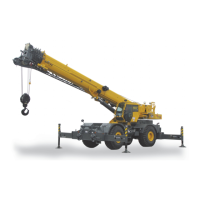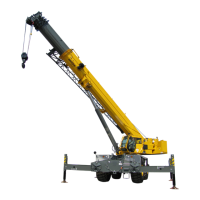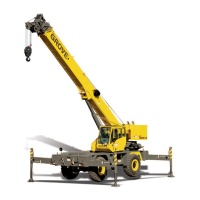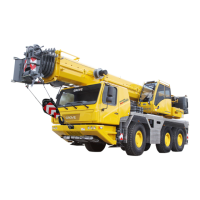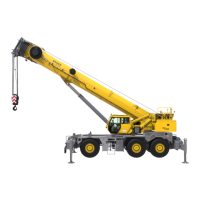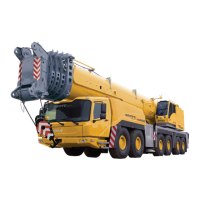OPERATING CONTROLS AND PROCEDURES RT765E-2 OPERATOR MANUAL
3-24 Published 4-09-2021, Control # 364-11
Hoist
Warm-up procedures are recommended at every startup and
required at ambient temperatures below 4°C (40°F).
Warm-up Procedures:
1. Without operating the hoist function, warm the hydraulic
oil (see Hydraulic Oil System, page 3-24).
2. Once hydraulic system is warm, operate the unloaded
hoist, in both directions, at low speeds several times to
prime all hydraulic lines with warm hydraulic oil and to
circulate gear lubricant through the planetary gear sets.
Swing Drive and Turntable Bearing
Warm-up Procedures for Temperatures Above -7°C
(20°F):
1. Setup crane on fully extended outriggers, with boom
fully retracted and near maximum lift angle with no load
applied.
2. Rotate superstructure at a speed of less than one RPM
for at least one complete revolution in one direction, then
rotate superstructure at a speed of less than one RPM
for at least one complete revolution in opposite direction.
Warm-up Procedures for Temperatures Below -7°C
(20°F):
1. Setup crane on fully extended outriggers, with boom
fully retracted and near maximum lift angle with no load
applied.
2. Rotate superstructure at a speed of less than one-half
RPM for at least two complete revolutions in one
direction, then rotate superstructure at a speed of less
than one-half RPM for at least two complete revolutions
in the opposite direction.
Axles
Warm-up Procedures for Temperatures Below -35°C
(-30°F):
1. Setup crane on outriggers.
2. Engage transmission with 4-wheel drive selected (if
equipped) and allow crane to run at idle until
transmission sump temperature reaches normal
operating temperature.
NOTE: Warm-up operation of 4-wheel drive transmission
engaged in 2-wheel drive only could cause
transmission damage.
Hydraulic Oil System
Operating Limits and Warm-up Procedures:
• From 4°C to -10°C (40°F to 15°F): Crane operation
without
a load is allowed with medium engine RPM and
medium function speed (joystick position) until fluid
reaches at least 10°C (50°F). It is then recommended
that all crane functions be cycled to remove cold fluid
from all components and cylinders of the hydraulic
system. If any unusual sound comes from the crane’s
hydraulic pumps or motors, stop operation and engine
immediately and contact a Manitowoc distributor.
• From 10°C to 4°C (50°F to 40°F): Crane operation with
a load is allowed with medium engine RPM and medium
function speed (joystick position) until fluid reaches at
least 10°C (50°F).
• From 95°C to 10°C (200°F to 50°F): Crane operation
with a load is allowed with no restrictions.
Above 95°C (200°F): No crane operation is allowed. Let
hydraulic oil cool by running engine at idle with no functions
actuated.
Engine Operation
Starting and shutdown procedures for most diesel engines
generally follow the same pattern. Therefore, the following
procedures can be applied except where specific differences
are noted. (Refer to the applicable engine manufacturers
manual for detailed procedures.)
Jump Starting Hazard
Do not attempt to jump start the crane.
This crane has multiple computer systems (crane control,
RCL, engine and transmission control) that are highly
susceptible to voltage/amperage surges in the electrical
system.
The batteries should be completely disconnected from the
crane electrical system and charged using a battery charger
of appropriate voltage level or replace the batteries with fully
charged batteries. Refer to Charging the Batteries, page 3-
24.
Charging the Batteries
When charging the batteries, do not turn on the battery
charger until the charging leads have been connected to the
battery(s). Also, if the battery(s) are found to be frozen, do
CAUTION
It is strongly recommended that the batteries not be
“jumped” with a different vehicle, portable power pack,
etc. The surge of power from these sources can
irreparably damage the various electronic controls and
computer systems. Jump starting the crane batteries
with a different vehicle while the engine is running can
damage the donor vehicle electronics as well if done
improperly.

